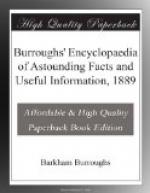He arrived at Coloma on the 7th of March, and found the work at the mill going on as if no gold existed in the neighborhood. The next day he took a pan and spade, and washed some of the dirt in the bottom of the mill-race in places where Marshall had found his specimens, and, in a few hours, Humphrey declared that these mines were far richer than any in Georgia. He now made a rocker and went to work washing gold industriously, and every day yielded to him an ounce or two of metal. The men at the mill made rockers for themselves, and all were soon busy in search of the yellow metal. Everything else was abandoned; the rumor of the discovery spread slowly. In the middle of March Pearson B. Reading, the owner of a large ranch at the head of the Sacramento valley, happened to visit Sutter’s Fort, and hearing of the mining at Coloma, he went thither to see it. He said that if similarity of formation could be taken as a proof, there must be gold mines near his ranch; so, after observing the method of washing, he posted off, and in a few weeks he was at work on the bars of Clear Creek, nearly two hundred miles northwestward from Coloma. A few days after Reading had left, John Bidwell, now representative of the northern district of the State in the lower House of Congress, came to Coloma, and the result of his visit was that, in less than a month, he had a party of Indians from his ranch washing gold on the bars of Feather River, twenty-five miles northwestward from Coloma. Thus the mines were opened at far distant points.
The first printed notice of the discovery of gold was given in the California newspaper published in San Francisco on the 10th of March. On the 29th of May the same paper, announcing that its publication would be suspended, says: “The whole country, from San Francisco to Los Angeles, and from the seashore to the base of the Sierra Nevada, resound the sordid cry of gold! gold! gold! while the field is left half planted, the house half built and everything neglected but the manufacture of pick and shovels, and the means of transportation to the spot where one man obtained one hundred and twenty-eight dollars’ worth of the real stuff in one day’s washing; and the average for all concerned, is twenty dollars per diem. The first to commence quartz mining in California were Capt. Win. Jackson and Mr. Eliason, both Virginians, and the first machine used was a Chilian mill.
The Reid Mine, in North Carolina, was the first gold mine discovered and worked in the United States, and the only one in North America from which, up to 1825, gold was sent to the Mint.
HOW TO MAKE ARTIFICIAL GOLD.
The following oroid or imitation gold is sometimes sold for the genuine article which it closely resembles. Pure copper, 100 parts by weight, is melted in a crucible, and then 6 parts of magnesia, 3.6 of sal-ammoniac, 1.8 of quicklime and 9. of tartar are added separately and gradually in the form of powder. The whole is then stirred for about half an hour, and 17 parts of zinc or tin in small grains are thrown in and thoroughly mixed. The [Transcriber’s Note: The original text reads ‘cruicible’] crucible is now covered and the mixture kept melted for half an hour longer, when it is skimmed and poured out.




